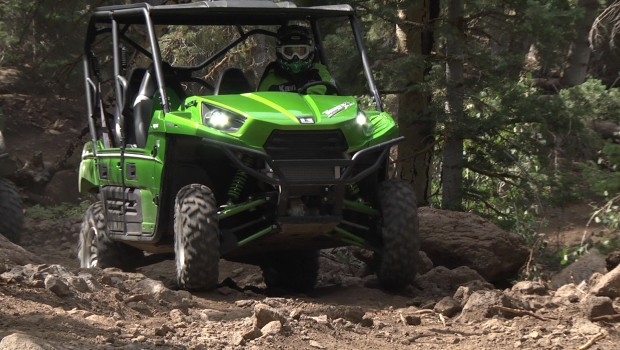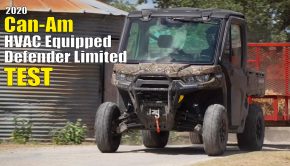2014 Kawasaki Teryx4 First Test: with VIDEO
More power, improved suspension, enhanced comfort, and rock solid construction built for four.
 There are many reasons that have led to side-by-sides dominating off-road sales in recent history. First, you can bring a friend, or in the Teryx4’s case, four friends along for the ride. While side-by-sides are more expensive to purchase, a family or group can purchase a side-by-side for less than the price of buying two to four ATVs and maintaining one UTV is less expensive than maintaining a couple quads.During our recent trip to Beaver, Utah with the crew from Kawasaki, we were reminded what may be the most alluring part of side-by-sides, the ability to relax in your seat and focus on all the beauty of the world passing by.
There are many reasons that have led to side-by-sides dominating off-road sales in recent history. First, you can bring a friend, or in the Teryx4’s case, four friends along for the ride. While side-by-sides are more expensive to purchase, a family or group can purchase a side-by-side for less than the price of buying two to four ATVs and maintaining one UTV is less expensive than maintaining a couple quads.During our recent trip to Beaver, Utah with the crew from Kawasaki, we were reminded what may be the most alluring part of side-by-sides, the ability to relax in your seat and focus on all the beauty of the world passing by.
Our reason visiting Beaver was to ride Utah’s Paiute trail system in Kawasaki’s significantly updated 2014 Teryx4. Heading into the event, the four-seat Teryx4 was already a favorite of ours due to its extreme build quality, interior comfort, and ability to flow through tight technical terrain that would leave other four-seat machines looking for reverse.As a vehicle we’d already felt confident spending our money on, we were eager to see how Kawasaki’s updates affected the Teryx4’s performance.

Our reason visiting Beaver was to ride Utah’s Paiute trail system in Kawasaki’s significantly updated 2014 Teryx4.
New Updated 800cc Class Engine

The 2014 engine updates are claimed to add up to an 8% increase in horsepower and a 10% increase in torque.
For 2014, the Teryx4’s 90 degree, V-twin engine has had its displacement increased from 749cc to 783cc. This was accomplished by increasing stroke by 3mm, from 66mm to 69mm. New pistons use the same 85mm more, but raise compression from 9.8:1 to 10.7:1. These changes were accompanied by revised cam profiles in the four-valve single overhead cam heads and an optimized exhaust to complement internal motor changes.
The engine updates are claimed to add up to an 8% increase in horsepower and a 10% increase in torque. Kawasaki focused the power gains around the bottom-end and midrange of the RPMs, helping the vehicle pull hard out of corners when it’s weighted down with occupants and equipment. The changes are also claimed to boost fuel range by 20%. That’s a lot of extra mileage.
The additional low-end power and torque were notable at lower elevations. However, we spent a lot of our time well over our starting elevation of 5000 feet. We felt the 2013 offered good performance in tight spaces. but the extra power is fun as the trail opens up a bit and lets you rip out of corners. Just to be kind to the transmission , we recommend shifting into low range for long runs under 15mph, especially if you’re climbing. The motor pulls hard enough down low that you feel like low range is useless unless you’re pulling or trying to climb a wall.
Throttle response remains impressive on the Kawasaki V-twin, building RPMs faster than the dated 760cc engine design used in the Polaris 800s.On long straights, the Teryx4 continues building power right up till the rev limiter kicks in. The Teryx4 remains governed around 51mph, which, honestly, rarely leaves you searching for more top speed.

The Teryx4’s fuel injection system does do a good job of keeping the air fuel mixture optimized, maintaining superb crispness and throttle response, as oxygen and horsepower fall off in the clouds.
Climbing up to around 11,500 feet above sea level, there is nothing a fuel injection system can do. As oxygen becomes less available, power falls off. The Teryx4’s system does do a good job of keeping the air fuel mixture optimized, maintaining superb crispness and throttle response, as oxygen and horsepower fall off in the clouds.
The pumped-up engine is mated to a CVT transmission with revised settings for the larger engine. The CVT utilizes a centrifugal clutch between the crankshaft and the main drive pulley. The utilization of the centrifugal clutch greatly reduces belt shock and shipping, extending the life of the Kevlar impregnated belt. The transmission features both high and low ranges plus neutral and reverse. Two and four-wheel-drive are selectable at the flip of a switch.
The clutch-equipped CVT provides a solid locked-in feeling even at lower speeds. Lag time is minimal when you hit the gas, adding to the sporty, responsive feeling of the engine.
The Teryx4’s engine braking system is helpful in controlling speeds while crawling down hills or when scrubbing off a little speed entering corners on long, high speed descents.
The four-wheel-drive system is simple and flawless with its locking front differential. We used it to prevent wheel spin on rocky climbs and we felt that having four-wheel-drive locked in helped us attack corners more aggressively on the faster switchback mountain trails, boosting corner exit speeds.
Thanks to the Teryx4’s electric power steering, now standard on all models, switching into four-wheel-drive has little effect on steering effort. The EPS also helps reduce bump feedback to the steering wheel enhancing control and improving comfort.
Chassis and Suspension
Kawasaki designed the Teryx4 with their gnarly Double X steel frame. Next, a ROPS cage surrounds the passenger compartment from top to bottom, where it ties into the Double X chassis, increasing strength and rigidity. The bottom of the ROPS acts sort of like a rock slider, protecting the lower outer edges from rocks and logs protruding beyond the machine’s 11.1 inches of ground clearance. Honestly, we would like to add an aftermarket set of skid plates, like the ones in the Kawasaki accessory catalog, that add a level of protection to the underside of the ROPS. The underside of the chassis has full coverage skid plates, with steel skid plates used to protect vital parts.

Dimensions remain mostly the same for 2014 with an overall width of 61.6 inches and a wheelbase of 85.7 inches giving the Teryx4 an advantage in the tight stuff.
Dimensions remain mostly the same for 2014 with an overall width of 61.6 inches and a wheelbase of 85.7 inches. Most four-seaters have wheelbases over 100 inches, giving the Teryx4 a significant advantage in the tight stuff. Somewhere between the shock, air ducting, and other changes, Kawasaki managed to take 29.1 pounds off the car, reducing the weight from 1,616 pounds to 1,586.9 pounds
Kawasaki went to work on the suspension for 2014, replacing the KYB shocks with preload and compression-adjustable Fox Podium shocks. More than just a name change, the new Fox shocks were set up to provide a plusher ride. Front wheel travel was booted slightly up from 7.8 to 8 full inches, while rear wheel travel remains unchanged at 8.3 inches.Tough looking a-arms at both ends work in conjunction with the new Fox shocks, making up the suspension system.
The Teryx4 is a machine that hangs out on the sport side of sport-utility. Steering is pretty predictable with a little bit of push when attacking high speed corners in two-wheel–drive.You’ve really got to charge a corner over-cooked to get the machine on two wheels. Fortunately, you can feel it coming when you are about to blow it. Stability is good both in turns and while traversing off-camber trails.

Kawasaki went to work on the suspension for 2014, replacing the KYB shocks with preload and compression-adjustable Fox Podium shocks.
With relatively the same wheel travel, the new shocks don’t change what’s possible with the Teryx4; however, they do improve upon what it is good at. Out of the box, the front suspension feels similar to last year’s. Back seat occupants will notice the most dramatic improvement in ride quality.Rear wheel tracking has been improved through rocks, bumps, and high-speed chatter, providing more precise handling and improved traction.
The shocks work pretty well at slow speeds; however, their stock settings seemed to work better the harder we pushed them. They do a good job of dealing with everything that the Paiute trails had to throw at them, from rocky sections right up to getting a little air flying over water breaks.Big jumps or trophy truck whoops are about the only obstacles that will have you lifting on the Teryx4.

the new shocks don’t change what’s possible with the Teryx4; however, they do improve upon what it is good at.
Some editors on hand felt that baking off a couple clicks on the front shocks’ compression damping improved plushness over small bumps and sharpened steering precision by allowing a bit more weight transfer. Taking much compression out of the rear creates too much body roll for aggressive driving. There is a lot of adjustment in these shocks. They work well out of the box, but taking the time to dial them in for your occupant weight and cargo will let you get the most out of the suspension.

Maxxis Bighorn tires have been a favorite upgrade among UTV enthusiasts for years now due to their superb traction and ride quality. 26-inch Bighorns come standard on the Teryx4
Maxxis Bighorn tires have been a favorite upgrade among UTV enthusiasts for years now due to their superb traction and ride quality. 26-inch Bighorns come standard on the Teryx4, mounted on 12in. cast aluminum rims. They are superb all-condition tires that provide good traction on a wide variety of conditions.
The Brakes
The Teryx4 is stopped by dual hydraulic disc brakes up front with 200mm rotors and dual piston calipers and Kawasaki’s signature sealed malty disc brake system out back, reducing maintenance. Steel braided brake lines enhance braking power and feel. We found them to offer good power and feel.
Comfort and details
The Teryx4 provides a high level of comfort whether you are in the front or back. The high back bucket seats are well padded and quite comfortable. Although a driver’s seat with a tool-less adjustment system would be a welcomed addition, legroom is ample up front and surprisingly good in the back even for passengers over six feet tall. The rear rollercoaster-style grab bar provides ample hand holds for rear occupants. Hand holds for the front passenger are found on the right cage down tube and next to the left of the seat ––not our favorite placement, but far better than the hand holds on the original two-seat Teryx.
The Teryx4 features high quality doors as standard equipment. The doors improve comfort and safety, helping keep mud and splashing water out and your legs in. Adding doors to competing machines will set you back $1000.
Work and Storage
In-cabin storage is available in the glove box with dual cup holders front and rear. The rear cargo bed has a weight capacity of 249 pounds and can be outfitted with various genuine accessories. The rear hitch receiver can tow an additional 1,300 pounds.
LE Features
Kawasaki has several LE versions of the Teryx4 that may have you taking notice. The LE model is available in Candy Lime Green, or Candy Burnt Orange. Both the LE and camo models feature cage roofs and LED lights. The painted LE models also feature color-matched a-arms, shock springs, and three-tone seat covers. The Camo model will set you back an additional $700, with the painted LE models costing an additional $1,200.
The verdict
Over the course of one week, two editor waves put over 500 miles of abuse on a fleet of over a dozen Teryx4s. While some of the drivers were skilled off-road enthusiasts, some were pretty new with less-developed driving skills.Amazingly, the only mechanical failures were a few flats caused by driver error, and one flook rock becoming lodged in the radiator’s cooling fan. Fortunately, a warning light on the machine warned us of the issue way ahead of major issues. The cooling fan was freed of its stowaway and the adventure continued. The point? The Teryx4 is a reliable, well-built machine. If you are planning on going some long distance tours like we did, reliability is everything.
Another huge asset of the Teryx is its 3-year limited warranty. That length of warranty makes you feel good, especially if you are financing the machine and plan on taking good care of it.

While the competition has clearly focused on building cars that excel in whooped-out desert terrain, Kawasaki focused on building a sporty four-seat machine that can cruise through wooded trails as effortlessly as most two-seaters.
Finally, there’s the performance. While the competition has clearly focused on building cars that excel in whooped-out desert terrain, Kawasaki focused on building a sporty four-seat machine that can cruise through wooded trails as effortlessly as most two-seaters. While we would love to see a long travel version for the desert crowd, the 2014 Teryx4 remains a stand-out machine on East Coast trails, and as a mountain goat whose performance, function, and style have been stepped up a bit for 2014.
2014 Kawasaki Teryx4: Ratings
Summary: While the competition has clearly focused on building cars that excel in whooped-out desert terrain, Kawasaki focused on building a sporty four-seat machine that can cruise through wooded trails as effortlessly as most two-seaters. While we would love to see a long travel version for the desert crowd, the 2014 Teryx4 remains a stand-out machine on East Coast trails, and as a mountain goat whose performance, function, and style have been stepped up a bit for 2014.














